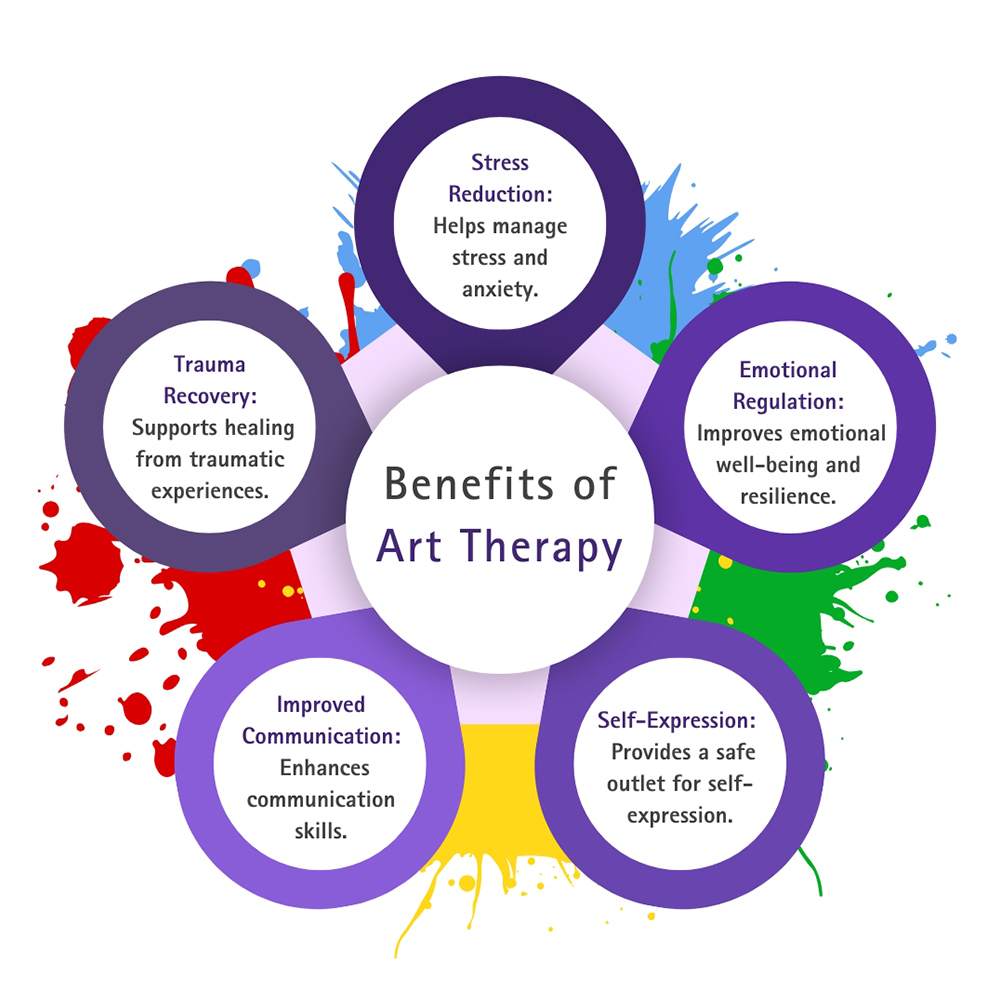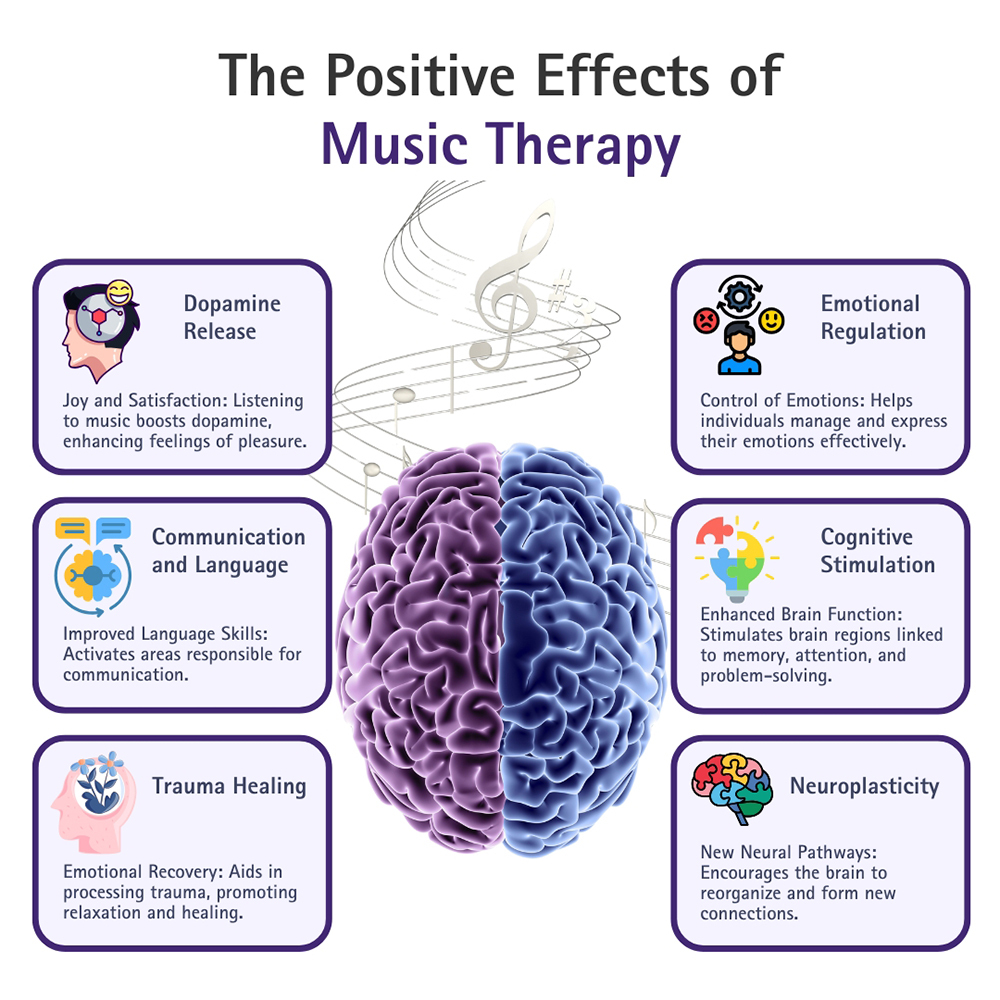What Is Art Therapy?

Art therapy is a mental health profession used to help clients use artistic expression to process thoughts, feelings, and emotions. Art therapy helps you improve mental, emotional, physical, and spiritual well-being. Art therapy is versatile in that it can be used in a variety of mental health settings and is used to treat an array of psychological conditions.
What Does an Art Therapist Do?
With the guidance of a trained art therapist, art therapy helps you express your emotions in a way that doesn’t require words. This process opens up a lot of things that are often left unsaid or unfelt. Your counselor will help you interpret your work with a series of guiding questions. Through art therapy, you can learn things about yourself and your feelings while having a safe way to process deep-rooted emotions.
Art therapy has a significant influence on the brain including:
- Emotional release
- Stress reduction
- Enhanced self-awareness
- Improved brain connectivity
- Mindfulness
- Dopamine release
- Increased brain plasticity
- Emotional regulation
- Improved memory and learning
Art therapy has been shown to have significant benefits for clients with many mental health conditions. Even for clients who are not struggling with anything specific, art therapy can help you learn about yourself and grow.

How Does Art Therapy Work?
Art therapy is a way to help you identify and express your emotions safely and creatively.
Here’s how art therapy generally works:
- Assessment: You and your therapist will decide what your goals are and what areas you would like to focus on. Your therapist will make suggestions and inform you of the process of art therapy.
- Creating art: Then you will begin creating art. Many different materials may be used such as pencil, pen, markers, clay, or collage. The focus is more on creating rather than artistic ability or making something “good”. You will begin expressing and releasing your subconscious thoughts and feelings through this process.
- Interpretation: You and your therapist will interpret your artwork together. Your therapist will guide you through identifying themes, symbols, and messages that you feel were expressed in your piece.
- Change: Through this process, you will begin recognizing behaviors and thought processes you may want to change. Your therapist will guide you through the steps necessary to make these changes in your life.
- Self-esteem boost: Creating a piece of art and receiving positive feedback and acknowledgment from your therapist increases confidence and self-esteem. Simply creating something increases dopamine in your brain, which is known as the “feel good” chemical.
Art therapy is led by a trained and skilled therapist at the Trauma Therapy Center, who provides a safe and supportive environment for fostering your creativity. Even if you are not an artist, you will be guided throughout the process and create something meaningful.
Embrace Healing The Power of Trust in Therapeutic Relationships
“In my experience, the most effective aspect of therapy is the therapeutic relationship. Establishing trust between a client and clinician is the first step to healing.”
Why Is Art Therapy Important?
Art therapy holds significance for multiple reasons including:
- Emotional expression: Sometimes, things are difficult to articulate. Art therapy helps release emotions with a creative approach.
- Self-exploration: Art therapy helps you learn more about yourself. Self-awareness is a crucial step in growth and self-improvement.
- Trauma healing: Art therapy can provide significant results through processing traumatic memories and feelings.
- Stress reduction: Creating art affects the stress centers of the brain to reduce stress and improve mood.
- Improved self-esteem: Experience how creating something personal can improve your self-confidence.
- Resilience: With art therapy as a tool, you will become more resilient in future challenges.
Art therapy has significant beneficial effects on reducing trauma symptoms and improving self-esteem. According to a research article published in Frontiers Psychology, art therapy was found to be effective in reducing the symptoms of CPTSD in adults, with participants reporting reductions in PTSD symptoms of up to 60%.
Is Art Therapy Covered by Insurance?
Art therapy is covered by most insurance providers. Contact your insurance policy directly to find out if art therapy is covered under your plan.
Is Art Therapy Evidence-Based?
Yes, art therapy has been researched and proven to be effective for:
- Trauma
- Anxiety
- Depression
- Eating disorders
- Substance use
- Bipolar disorders
- Schizophrenia
- Autism
- Borderline personality disorder
- ADHD
- Grief and loss
- Stress management
- Seasonal Affective Disorder (SAD)
Art therapy is highly effective for clients of all ages and backgrounds. Art therapy is often used in combination with other talk therapies. Talk to your therapist to find out more information about how art therapy can help you.
What Is Music Therapy?
Music therapy is a therapeutic practice used by board-certified therapists to help you overcome mental, emotional, and physical challenges. Music therapists guide you through the use of music for emotional release to improve your overall quality of life and achieve specific therapeutic goals.
What Is Music Therapy Used For?
Some diagnoses music therapy is used for include:
- Autism spectrum disorder
- Depression
- Anxiety
- Dementia and Alzheimer’s disease
- Post-traumatic stress disorder (PTSD)
- Learning disabilities
- Substance use
- Bipolar disorder
- Schizophrenia
Music therapy is highly individualized so it is important to talk to your therapist about your music therapy treatment plan. Music therapy is highly versatile and adaptable, which means it can be used for a wide range of mental health conditions.

How Does Music Therapy Affect the Brain?
Music therapy has been shown to have significant positive effects on the brain. Some positive effects of music therapy include:
- Emotional regulation: Music therapy helps you learn to manage and control your emotions.
- Cognitive stimulation: Practicing music stimulates multiple parts of the brain associated with memory, attention, and problem-solving skills.
- Neuroplasticity: Music therapy helps create new neural pathways in your brain.
- Dopamine release: Music stimulates the neurotransmitter dopamine, associated with pleasure and reward.
- Communication and language: Music therapy can engage parts of the brain responsible for communication and language.
- Trauma healing: Trauma can manifest physically. Music therapy helps relax and release trauma through the body.
Music therapy for trauma should be performed by a licensed mental health professional in a safe and controlled setting.
How Does Music Therapy Help Alzheimer’s?
Music therapy can help with Alzheimer’s through:
- Memory recall: Music can evoke strong emotions and memories. Music can help Alzheimer’s patients connect with memories from their past.
- Cognitive processing: Music affects cognition, such as memory, attention, and problem-solving.
- Anxiety reduction: Music has the power to affect mood and help relax the mind and body.
- Enhance communication: Music works on areas of the brain that improve memory and verbal and non-verbal communication.
Art therapy at the Trauma Therapy Center in West Palm Beach offers a unique, transformative journey of healing. Our experienced art therapists are dedicated to helping you express your emotions, reduce stress, and enhance self-awareness. Don’t miss the chance to experience the profound benefits of art therapy. Reach out to us today.

